sugar
now browsing by tag
Leaky Gut & Diabetes by Terry Ryan
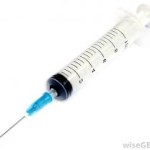
Nearly 26 million Americans have either Type I or Type II diabetes at a cost of more the $245 billion  annually. The American Diabetes Association estimates that by 2050, as many as 1 in 3 American adults will have diabetes. While the majority of diabetes research, publicity, and health care dollars focus on Type 2 diabetes and obesity, we need to pay attention to type 1 diabetes. The incidence of Type 1 diabetes (T1D) has increased significantly worldwide just in the last few decades, and it is important we focus our energy on it as well.
annually. The American Diabetes Association estimates that by 2050, as many as 1 in 3 American adults will have diabetes. While the majority of diabetes research, publicity, and health care dollars focus on Type 2 diabetes and obesity, we need to pay attention to type 1 diabetes. The incidence of Type 1 diabetes (T1D) has increased significantly worldwide just in the last few decades, and it is important we focus our energy on it as well.
Type I diabetes can occur in both adults and children and is due to destruction of the cells in the pancreas called beta cells. Diabetes can start suddenly and symptoms may include:
- Extreme thirst
- Increased urination
- Increased appetite
- Sudden weight loss
- Fatigue or lethargy
- Sudden vision changes
- Fruity odor to the breath
It is caused by the immune system attacking the pancreas, i.e. it is an autoimmune disorder. The pancreas can no longer make insulin because the beta cells have been destroyed and insulin must come from an outside source. It is a constant daily challenge for these individuals to manage their blood sugar.
Medical history shows that childhood diabetes, or Type 1 diabetes, was quite rare in several countries across the world and showed no change in incidence from 1925-1955. The 1892 edition of Osler’s Principles and Practice of Medicine mentions that only 10 patients out 35,000 treated at Johns Hopkins had diabetes (1 and 2). Massachusetts General Hospital recorded admitting and treating 172 patients with diabetes from 1824-1898, of which there were only 18 patients under the age of 20. However, an increase in the prevalence of T1D has been documented since the mid 1900’s and has been steadily increasing since then.
Compare historical findings to the latest statistics. There are three million Americans with Type 1 diabetes 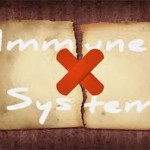 with more than 15,000 children and 15,000 adults diagnosed each year. There has been a 23% increase in prevalence of Type 1 diabetes in children and teenagers between 2001 and 2009. Many argue these statistics, reasoning that it is simply better diagnostic techniques, recognition, and statistics. The topic continues under debate, but the numbers are clear. The illness is impacting more every year.
with more than 15,000 children and 15,000 adults diagnosed each year. There has been a 23% increase in prevalence of Type 1 diabetes in children and teenagers between 2001 and 2009. Many argue these statistics, reasoning that it is simply better diagnostic techniques, recognition, and statistics. The topic continues under debate, but the numbers are clear. The illness is impacting more every year.
Leaky Gut Syndrome and Type I Diabetes
For decades, medical research has been trying to understand the causes of Type I diabetes. They face many of the same challenges in understanding why the autoimmune disorder occurs as other autoimmune diseases. There have been many theories over the years and research continues to delve into the causes of T1D.
There is strong evidence coming to light that environmental products and subsequent development of digestive issues are triggering autoimmune destruction of pancreatic beta cells leading to Type I diabetes in both children and adults.
Several recent studies have now identified that altered or increased intestinal permeability (Leaky Gut Syndrome) is actually responsible for the onset of Type 1 diabetes. This altered mechanism occurs before the onset of complications, i.e. full blown destruction of the pancreatic beta cells. Animal studies showed that the altered intestinal permeability preceded the onset of diabetes by at least one month. This increase in gut permeability does not occur as the cause in Type II diabetes, but specifically to Type 1 diabetes. Human studies show that this breakdown and change in tight junctions and zonulin* is present in at least 50 % of T1D patients.
In addition to the presence of increased gut permeability prior to T1 D development, the medical journal Diabetes reported that at least half of T1D patients had an abnormal T-cell immune response to dietary wheat proteins and triggered different gene expression than Celiac Disease patients. Meaning when T1D patients were tested for the traditional Celiac Disease lab marker, tissue transglutaminase IgG and IgA, their markers were negative and many times there were no digestive symptoms like with Celiac Disease. However, when tested for other wheat peptides, their markers reacted with a positive finding. It was a completely different gene that was being triggered by wheat/gluten not measured by the standard medical marker and provoked a T-cell immune response against the pancreas. Wheat has been proven in animal studies as a trigger for T1D, but now researchers are seeing this “silent” association in human studies. In fact, the association of T1D with other autoimmune disorders, commonly Celiac Disease and Hashimotos’sthyroiditis, has been known for quite sometime. The scope has widened beyond traditional Celiac Disease markers and T1D.
Knowing that increased gut permeability precedes T1D onset and that wheat/gluten autoimmunity is present at least half the time in T1D development is powerful information. This is a huge breakthrough in understanding T1D and autoimmunity. Testing wheat/gluten autoimmunity and reactivity, increased zonulin levels, and intestinal permeability are now easily done by blood tests leaving the guess work out of the picture.
Gut Flora
Researchers are diligently studying the gut microbiome imbalances or alterations in gut flora and have found that it is clearly associated with increased gut permeability. This means that a germ, i.e. yeast or bacteria that should not be in the digestive tract, can clearly initiate Leaky Gut Syndrome. The antibiotic that was taken by a child for an upper respiratory infection, acne, or the ear infection, can trigger this gut microbiome imbalance. Combine that with the athlete who is trying to make varsity team in high school or college. Then throw in disrupted gut clocks and altered sleep-wake schedules that teenagers often experience while consuming the standard American Diet of white flour (gluten) and white sugar and lots of fast food stops after school. How about the weekend warrior athlete with the same factors? It can be the perfect storm for the development of Type 1 diabetes. <Screammmmmm>
Researchers are studying other autoimmune disorders and there is mounting evidence that several diseases follow this same change in tight junctions and zonulin function leading to Leaky Gut Syndrome and autoimmune inflammation. It also includes other disorders such as asthma, rheumatoid arthritis, lupus, inflammatory bowel disease, several types of cancers including brain and pancreatic cancer, chronic inflammation, and schizophrenia. This is similar to Celiac Disease, thyroid problems, and candida overgrowth.
Help!
There are several solutions that can be used to help support the body in the case of Type 1 diabetes. It is imperative to be tested for “wheat/gluten proteome reactivity and autoimmunity” and remove these food intolerances if present. It is absolutely vital to also include organic, fermented foods like fermented veggies or probiotics that help support beneficial gut bacteria. It is just as imperative to work on reducing the risk and consequences of Leaky Gut Syndrome. There are several compounds that help reduce this inflammatory response and reduce the risk for T1D. These include L-glutamine, probiotics, vitamin D, and Omega 3 oils.
There also is the whole aspect of helping blood sugar work better and reducing the consequences of elevated blood sugar and AGEs or Advanced Glycation End Units. No matter what age you are, if you have T1D, you have to be proactive lifelong about reducing AGEs responses. Several nutrients can help support this process:
These has been shown to protect against AGEs, but it also helps to protect T- cells that may be part of the issue for Type 1 diabetes. Because poorly controlled blood sugar damages capillaries, kidneys, eyes, nerves in anyone with Type 1 diabetes and Type 2 diabetes, as well as those who have borderline blood sugar levels, it is vital to be proactive about these concerns. A young child with T1D has a lifetime ahead of them. Let’s help protect these children and adults from further damage, or if possible, reduce the risk for the disease from occurring. Be proactive!
*Zonulin is a protein that modulates the permeability of tight junctions between cells of the wall of the digestive tract.
Special thanks to Linda J Dobberstein, DC, DACBN, DCBCN for the above information.
Terry Ryan is a health blogger and lives in Sarasota, FL with her husband, Kenan.
The End of The 30 Day Juice Challenge

I have completed the 30 Day Juice Challenge and wanted to give you my personal review.
 It wasn’t hard and became routine so I give it a 10 on the easy scale. Let me add that I work from home so it is easy for me to prep and prepare juicing at my leisure. It would be much harder for a person who has a 9-5 job to prepare for juicing.
It wasn’t hard and became routine so I give it a 10 on the easy scale. Let me add that I work from home so it is easy for me to prep and prepare juicing at my leisure. It would be much harder for a person who has a 9-5 job to prepare for juicing.
As far as taste, it is something you will get used to. It only took me a couple of times to look forward to the juice. I also flavored it up with apples and ginger. After that even kale is pretty yummy. Who would of thought?
I didn’t find the cost prohibitive. I buy lots of produce every week anyway so this wasn’t a new area for me. Previously to my juicing challenge I tried to get as much organic as possible so I was already on the right track.
My disappointment was with the weight loss which was only a couple of pounds even though I was using once a day juicing as a meal replacement and gave up sugar and gluten. I did lose a few pounds but not the 20 I was hoping for. (sigh)
I felt fine but never got the “I feel like I have the energy of a 20 year-old.” Nope! It didn’t happen. I 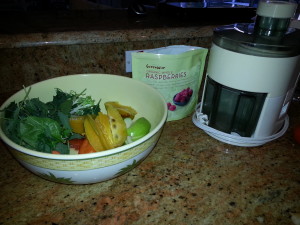 would say my energy level only increase a tiny bit. That for me was my biggest disappointment.
would say my energy level only increase a tiny bit. That for me was my biggest disappointment.
The best benefit was my skin became flawless and glowed, so I at least looked better. I no longer craved sugar or processed carbs. My taste buds now desired a higher grade of eating.
So, what I learned:
I may have to juice 100% everyday to get the full benefits that Joe Cross brags about on Fat, Sick and Nearly Dead.
I am using the wrong juicer. I am using a cheap juice extractor and that doesn’t get the most juice out of the veggies and it heats the foods up destroying enzines and nutrients. See my post on Juicing vs. Blending.
Will I continue juicing? Yes, I will but not so dedicated. To complete my experiment, I am going to try juicing 100% for 7 days to see if I get WEIGHT LOSS and FANTASTIC ENERGY, but not right now. I need a break. I was doing Holy Juicing for Lent but I think I lost my followers who were doing it with me. Yes, it’s hard.
One thing I am sticking to is giving up white sugar and process foods. Yuck. And breads with
gluten. Bread just doesn’t agree with me anymore. Of course they are now putting all kinds of disgusting and dangerous chemicals in bread. All to keep it on the shelf longer and to make more money. No problem, there are tons of breads in the freezer section at the store that are gluten free and I have a great recipe for almond bread.
There you go. My review of the 30 Day Juicing Challenge.
What the Heck is Diabetes?

 What the heck is diabetes? Yes, I’m sure you have heard of it…and that it’s increasing. My endocrinologist’s office is filled with patients with Type 1 and 2 diabetes making it difficult for us thyroid sufferer to make an appointment. Okay, that’s only slightly true but according to JAMA over 44 million now considered obese
What the heck is diabetes? Yes, I’m sure you have heard of it…and that it’s increasing. My endocrinologist’s office is filled with patients with Type 1 and 2 diabetes making it difficult for us thyroid sufferer to make an appointment. Okay, that’s only slightly true but according to JAMA over 44 million now considered obese
Currently, more than 44 million Americans are considered obese by body mass index (BMI), reflecting an increase of 74 percent since 1991. During the same time frame, diabetes increased by 61 percent, reflecting the strong correlation between obesity and development of diabetes. Today an estimated 17 million people have diabetes in the United States. And this was in the journal Lancet: An international study has revealed some shocking statistics. In less than 30 years, between 1980 and 2008, the number of people with type 2 diabetes more than doubled around the world, rising from 153 million to 347 million.
Yikes, right! But let me put what diabetes is in simple words.
Type 2 diabetes accounts for 90-95% of all cases of diabetes. Type 2 diabetes is caused by eating too much sugar. Remember, sugar has 56 names.(Click here for the 56 Names of Sugar) Here’s how it works. When you eat a meal, the carbs in your food are broken down into glucose. The glucose enters your bloodstream where it is carried throughout your body to give…energy! Your pancreas in turn releases the hormone insulin to help your cells turn glucose into energy. What happens when there is too much sugar over and over again? Your body becomes insulin resistant. So, the pancreas sends more and more insulin out (poor pancreas) into the bloodstream so glucose can convert to energy but keep going along like this; forcing more insulin into your bloodstream, and your pancreas won’t be able to keep up. What happens instead is that the glucose becomes trapped into your bloodstream, and the cells of your muscles and organs are starved for energy. Eventually, this causes organ and nerve damage.which eventually will lead to heart disease, eye sight damage, limbs being amputated, strokes, etc.
That’s why your grandparents used to call it SUGAR. Because you give a urine sample and if you are experiencing diabetes an over abundance of glucose will present in your sample. Now, it is know as simply diabetes – type 2.
Type 1 diabetes is usually diagnosed in children and young adults, and was previously known as juvenile diabetes. Only 5% of people with diabetes have this form of the disease.
In type 1 diabetes, the body does not produce insulin. Insulin is a hormone that is needed to convert sugar, starches and other food into energy needed for daily life. With the help of insulin therapy and other treatments, even young children can learn to manage their condition and live long, healthy lives.
– See more at: http://www.diabetes.org/diabetes-basics/type-1/#sthash.meThJ71C.dpuf
Are You at Risk for Type 2 Diabetes?
- A waist that is 35 or more inches in diameter of you’re a woman or 40″ if a man.
- A Blood triglyceride of 150 or greater.
- Fasting blood sugar greater than 100mg.
Symptoms you may have type 2 diabetes:
- Common symptoms of diabetes: Urinating often Feeling very thirsty Feeling very hungry – even though you are eating
- Extreme fatigue
- Blurry vision
- Cuts/bruises that are slow to heal
- Weight loss – even though you are eating more (type 1)
- Tingling, pain, or numbness in the hands/feet (type 2) –
- See more at: http://www.diabetes.org/diabetes-basics/symptoms/#sthash.souFT766.dpuf
What you can do to prevent developing type 2 diabetes.
Eat a well balanced diet that is high in vegetables, low in simple carbohydrates, zero in refined sugar except on your birthday and maybe Christmas…if you must, and, this is a big one…cut out the alcohol.
I recently read a magazine about diabetes and they had some recipes that included chocolate cake. Come on! Chocolate cake? Yes, it had stuff like sugar and white flour. No, not a good thing to eat if you have or have not diabetes. This recipe for 1 Minute Chocolate Cake is the correct recipe for preventing diabetes:
1-Minute Cake With Almond Flour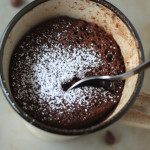
1/4 cup Truvia Baking Blend
1/2 cup almond flour
3 tbsp unsweetened cocoa powder
1/8 tsp baking powder
1/2 tsp baking soda
1/4 tsp salt
2 tbsp coconut oil
1 egg
2 tbsp half & half
Directions
Mix all ingredients together in a bowl until the mixture is even and smooth (no lumps).
Pour 1/4 of the mixture into a mug and microwave for 1 minutes.
Refrigerate remaining batter for later!
I like to add unsweetened whipped cream on top. No sugar carbs in this recipe!
If you suspect you have symptoms of diabetes it is imperative to seek a doctor’s advice as soon as possible and be tested. I have my blood tested every year.There is medicines that can control diabetes and in severe cases, insulin injections. Hopefully, you will keep good healthy eating habits and avoid that long, dark ride down type 2 diabetes lane.
Karen’s Story-It wasn’t About Losing Weight

 I love Karen. She has always been a great friend and we have known each other since high school and we even went to the same college. After all these years, we have kept in touch.
I love Karen. She has always been a great friend and we have known each other since high school and we even went to the same college. After all these years, we have kept in touch.
Karen is a real beauty; close to 6 ft tall with dark hair and perfect features she could have been a model. But not only is Karen beautiful on the outside she also has a beautiful and caring personality. She cares so much about people and animals that she volunteers at a nursing home and at animal rescues.
Karen’s weight has always gone up and down on the scale. In college we all put on the freshman 10 or 20 but we would also lose them. As we grew older it was harder to lose and easier to put on weight. Karen and I both got heavier and heavier.
A couple of years ago, Karen and I met halfway between our homes at a coffee shop. Boy was I shocked when I saw her. She must have lost 40 pounds and looked wonderful and full of vitality. Karen told me her weight loss was a result of a healthier diet. She wasn’t feeling well and suspected it was the food that she was eating that was making her feel that way. She said she felt bloated and edgy. After reading a couple of health books she realized that she may have food allergies and started eliminating certain foods from her diet. Top of the list to eliminate: wheat and sugar. After 7 days of not eating these foods, she felt the benefits and started to lose weight…a nice side effect. “It was all about feeling better and never about losing weight,” said Karen. She never gets on a scale so she has no idea how much weight she has lost.
“It’s not about the weight, it’s all about the healing.
What I weigh does not matter.”
She did point out that when you start the better-health journey you should not look outside of yourself for validation. Most people will not understand your new diet or may even mock you, and your family will be eating differently than you do. She said she got her support through websites that concentrated on health, reading health/diet books, meditation, and meeting other people who felt the same way about food as she did.
“I feel good in my own body, and I have become aware of how different foods affect me.”
A typical day for Karen:
Breakfast~
2 Cups of black coffee and lots of water with Braggs Apple Cider Vinegar (When I asked her how much Braggs she puts in her water she said she doesn’t measure anything. She just pours some in the water and loves the taste.)
2 Hard boiled eggs with a drizzle of olive oil
Lunch~
Baked chicken with veggies
Dinner~
Same as lunch
Snack is a couple of spoonfuls of unsweetened apple sauce mixed with cashew butter throughout the day.
Karen’s tip is: Start the day eating just pure protein. It makes you feel more satisfied than starting the day with carbs.
I asked her if she ever binges. She said, “No.”
If she goes to a party and there is a cake she will have a slice and eat the entire piece (this is a rare occurrence), and she says she can feel that old sugar addiction kick in. But that is it. She then won’t have any sugar for months. She said it takes her about 7 days to get over the cravings for sugar.
Karen says what she misses most of all is crusty bread and dipping it into olive oil. She eats no dairy and drinks no alcohol nor does she miss it.
As far as exercise, Karen does yoga and takes walks but hitting the gym and sweating on a treadmill is not something she would do.
A good point that she brought up is the jealousy that you will sometimes feel when you see other people eat and drink what they want and seem to look fine or suffer no consequences. She said that you have to depend on self-loving yourself when this happens and also find your tribe; people who you relate to and that relate to you.
Karen has done a couple of fasts but does not recommend them unless you have thoroughly studied up on them and proceed under a professional’s care. She said they can be very dangerous if you are taking medications because a fast can be toxic. Proceed with extreme caution when considering a fast. She said her longest fast was for 4 days and that after 2 days she felt amazingly calm and had no cravings. But for other people who fast, they may feel horrible as toxins are released from their body. Again, the best advice if you want to do a fast is find a physician who is familiar with fasting and can offer advice.
Karen’s reading suggestions:
Alkalize or Die: Superior Health Through Proper Alkaline-Acid Balance
Theodore A. Baroody
Clean Gut: The Breakthrough Plan for Eliminating the Root Cause of Disease and Revolutionizing Your Health
Alejandro Junger
Apple Cider Vinegar Miracle Health System
Paul C. Bragg
Wheat Belly: Lose the Wheat, Lose the Weight, and Find Your Path Back to Health
William Davis
Sara Gottfried
Thank you for reading! Terry Ryan

White Poison-Sugar!
5 Clues You Are Addicted to Sugar
Most of us have felt the urge, the unstoppable craving driving us to seek out something sweet and devour it in a flash. That uncontrollable yen for cookies, cake or ice cream or that whole basket of bread calling to us to finish it off. Why do you overeat? Why does that cookie have such power over you, even though you know it will make you fat and sick? Is it an indication of your moral weakness, lack of will power, or is it a powerful hardwired brain response over which you have little control?
Debate has raged recently about whether junk food, the hyper-processed, hyper-palatable food that has become our SAD (standard American diet) is addictive in the same way that heroin or cocaine is addictive. A new study published in the American Journal of Clinical Nutrition suggests that, in fact, higher sugar, higher glycemic foods can be addictive.
David Ludwig, author of Ending the Food Fight, and his colleagues at Harvard, in a very sophisticated study, showed that foods with more sugar, foods that raise blood sugar even more than table sugar such as white flour, white potatoes and refined starch have what is called a high glycemic index, trigger a special region in the brain called the nucleus 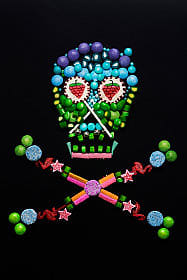 accumbens that is known to be “ground zero” for conventional addiction, such as gambling or drug abuse.
accumbens that is known to be “ground zero” for conventional addiction, such as gambling or drug abuse.
It appears part of the reason almost 70 percent of Americans are overweight or one in two Americans has pre-diabetes or Type 2 diabetes may not be gluttony, lack of willpower or absence of personal responsibility but plain old, garden variety biological addiction.
Many previous studies have shown how this region of brain, the pleasure center, lights up in response to images or eating sugary, processed or junk food. But many of these studies used very different foods as a comparison. If you compare cheesecake to boiled vegetables, there are many reasons the pleasure center can light up. It tastes better or it looks better. This is interesting data, but it’s not hard proof of addiction.
This new study took on the hard job of proving the biology of sugar addiction. The researchers did a randomized, blinded, crossover study using the most rigorous research design to ward off any criticism (which will inevitably come from the $1 trillion food industry).
They took 12 overweight or obese men between the ages of 18 and 35 and gave each a low sugar or low glycemic index (37 percent) milkshake, and then, four hours later, they measured the activity of the brain region (nucleus accumbens) that controls addiction. They also measured blood sugar and hunger.
Then, days later, they had them back for another milkshake. But this time they switched the milkshakes. They were designed to taste exactly the same and be exactly the same in every way except in how much and how quickly it spiked blood sugar. The second milkshake was designed to be high in sugar with a high glycemic index (84 percent). The shakes had exactly the same amount of calories, protein, fat and carbohydrate. Think of it as a trick milkshake. The participants didn’t know which milkshake they were getting, and their mouth couldn’t tell the difference, but their brains could.
Each participant received a brain scan and blood tests for glucose and insulin after each version of the milkshake. They were their own control group. Without exception, they all had the same response. The high sugar or glycemic index milkshake caused a spike in blood sugar and insulin and an increase in reported hunger and cravings four hours after the shake. Remember — exactly the same calories, sweetness, texture and macronutrient content.
This finding was not surprising and has been shown many times before.
But the breakthrough finding was this: When the high glycemic shake was consumed, the nucleus accumbens lit up like a Christmas tree. This pattern occurred in every single participant and was statistically significant.
This study showed two things.
First, the body responds quite differently to different calories, even if the protein, fat and carbs (and taste) are exactly the same.
And second, foods that spike blood sugar are biologically addictive.
This game-changing study must force a shift in the conversation about obesity in America. There are 600,000 processed foods in the marketplace, 80 percent of which have added hidden sugar. The average American consumes 22 teaspoons of sugar a day, mostly hidden, and the average teenage boy has 34 teaspoons a day (more than two 20 ounce sodas). One serving of Prego tomato sauce has more sugar than a serving of Oreo cookies. Sweetened yogurts can have more sugar than a can of soda.
Sugar is the core ingredient used by the food industry to make bad ingredients (processed flour and chemicals) taste good. Our consumption has increased from 10 pounds per person in 1800 to 140 pounds per person per year today.
Each year, the average American also consumes 133 pounds of white or wheat flour, which raises blood sugar more than table sugar (sucrose).
When a 12-year-old boy needs a liver transplant after a steady diet of soda and white flour, or when a 2-year-old can’t walk because he is too fat at 50 pounds, we can no longer point to personal responsibility as the solution to our obesity epidemic.
What if Kobe Bryant or LeBron James went on national television promoting the benefits of “cocaine water” to increase sports performance? Would you allow heroin dispensers in your kid’s school? Think heroin lollipops or morphine muffins. This is exactly what’s happening in America today.
No one wants to be fat or become a drug addict. No one wants their life destroyed by disability and illness. We have policies and laws that protect people from alcohol, tobacco and illegal drugs of abuse. Sugar and flour (and too much starchy white potatoes and white rice) or products containing them appear to be no different. In fact, some animal studies show that sugar is eight times as addictive as cocaine.
It is time to stop blaming the fat person. Can we really blame our children if we freely give them drugs of abuse in the school lunch line or as after school snacks? Can we really blame the average overweight person? The nutritional landscape in America is a food carnival.
Kelly Brownell from Yale’s Rudd Center for Food Policy and Obesity has created a validated food questionnaire to help you determine if you are a food addict. He recently also published a textbook, Food and Addiction, that lays out the science of how our hyper-processed, hyper-palatable, hyper-sweet industrial food has hijacked our brain chemistry and biology.
Here are five clues you may be addicted to sugar, flour and processed food:
- You consume certain foods even if you are not hungry because of cravings.
- You worry about cutting down on certain foods.
- You feel sluggish or fatigued from overeating.
- You have health or social problems (affecting school or work) because of food issues and yet keep eating the way you do despite negative consequences.
- You need more and more of the foods you crave to experience any pleasure or reduce negative emotions.
If you are among those whose brain chemistry, taste buds and hormones have been hijacked by the food industry (up to 70 percent of us, including 40 percent of children), then it is time to stop blaming yourself and consider food rehab or a sugar detox. It is time for all of us to take back our health and demand that our children be protected from addictive substances in our schools and from the insidious marketing practices directed at them from the food industry.
There are resources to help you break your food addiction and stop the cravings.
Now, I would love to hear from you.
Have you experienced uncontrollable cravings for sugar and refined foods?
How has it affected your life?
Have you blamed yourself for your behavior?
Do you think we should change food policy to protect children from marketing of foods proven to be addictive?
To your good health,
Mark Hyman, MD




 D5 Creation
D5 Creation